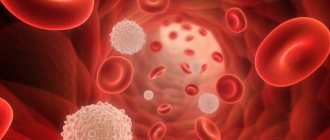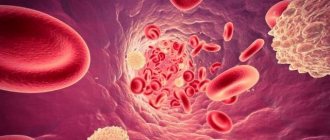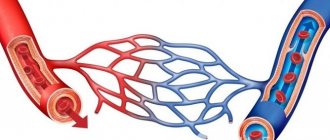Leukopenia is a pathological condition that is characterized by a decrease in leukocytes in the blood (less than 4 x 109/l), including all cells of the leukocyte formula (neutrophils, monocytes, lymphocytes, basophils). Such changes may be reactive, or may be indicators of a malfunction of the bone marrow, which produces white blood cells.
This condition is caused by massive destruction of young blood cells and a decrease in the formation of mature leukocytes, which are the basis for the proper functioning of the immune system.
| Leukocytes are protective blood cells that are an integral part of the immune system. They “destroy” foreign elements, produce biologically active substances, and take part in inflammatory processes. · Therefore, an imbalance of leukocytes leads to a decrease in the body’s defenses, thereby increasing its vulnerability to various types of infections. The severity of the pathological process depends on the rate of reduction of leukocytes in the blood. |
In some clinically healthy people, leukopenia is considered normal.
However, in most cases, a decrease in leukocytes is a pathological condition that develops against the background of primary or secondary causes.
By origin they are:
- Endogenous (hormonal imbalance, inflammatory process in the body, genetic predisposition).
- Exogenous (bacteria, viruses, fungi, parasites).
Infectious and non-infectious.
Leukopenia
The diagnosis of “leukopenia” means a low level of white blood cells - leukocytes, which are an important element of the immune system (doctors call them immunocompetent cells).
In adults, the limit is considered to be 4000 leukocytes per 1 microliter of blood. For children, the threshold value is calculated individually, taking into account age. Experts distinguish several types of leukopenia depending on which white blood cells are insufficient (lymphocytes, neutrophils, monocytes, etc.). Most often, a deficiency of neutrophils is diagnosed, which are responsible for protecting the body from bacterial and fungal infections; in this case, a diagnosis of neutropenia is made. In second place in the frequency of cases is a lack of lymphocytes, which provide protection against viral diseases.
Why does this state matter to us?
Leukocytes are responsible for immunity and resistance to various unfavorable factors, therefore, when their level in the blood decreases, the body’s “defense” is primarily affected.
In this case, a person becomes more vulnerable to any infection: bacterial, viral or fungal.
In most cases, with the development of infectious complications, specialized antitumor treatment should be postponed. Consequently, in addition to the main danger for humans, which lies precisely in the infectious process, we are also faced with the fact that we have to postpone the treatment of cancer indefinitely until we deal with the infection.
Reasons for the development of leukopenia
A decrease in the number of white blood cells in the bloodstream can be due to three main reasons:
- Disruption of the process of formation of leukocytes. The latter are produced in the thymus gland, lymph nodes, spleen, tonsils, intestinal lymphoid nodules and bone marrow tissue - problems in the functioning of any of these organs can lead to disruptions in the production of blood cells.
- Destruction of leukocytes.
- Impaired circulation of leukocytes in body tissues.
The listed disorders can be caused by hereditary factors. These are congenital pathologies that impair the functions of the bone marrow, such as Kostman's syndrome - in such cases they speak of primary leukopenia, which is quite rare. A more common option is secondary (acquired) leukopenia. One of the most common factors causing the development of leukopenia is radiation or chemotherapy, which disrupts the production of mature leukocytes. However, there are other reasons:
- Autoimmune disorders accompanied by the destruction of bone marrow cells and/or leukocytes.
- Blood diseases (acute leukemia, anemia).
- Viral infections that deplete leukocyte reserves (the body does not have time to reproduce new blood cells).
- Taking a number of medications. These include antibiotics, cytostatics, anti-inflammatory drugs (such as analgin), as well as anticonvulsants, neuroleptics, etc.
- The effect of toxic substances such as carbon monoxide, mercury, lead.
- The effect of negative physical factors, for example, ionizing radiation.
Leukopenia often accompanies the following diseases:
- HIV infection;
- tuberculosis;
- systemic vasculitis;
- joint diseases (rheumatoid arthritis, etc.);
- inflammatory bowel diseases (Crohn's disease, etc.);
- multiple sclerosis;
- endocrine disorders.
A decrease in the number of leukocytes can also be observed after a blood transfusion and during protein starvation (malnutrition, lack of vitamins).
In children, the most common causes of secondary leukopenia are infectious diseases such as influenza, measles, and mumps.
Causes of the disease
The causes of leukopenia may be due to:
Diseases of blood cells (bone marrow)
- Myelofibrosis;
- Aplastic anemia;
- Enlarged spleen;
- Myelodysplastic syndrome.
Congenital pathologies
- Kostman's syndrome;
- Myelocathexis;
- Kidney failure;
- Itsenko-Cushing syndrome;
- Gensler's syndrome.
Infectious diseases
- ARVI;
- Hepatitis;
- Rubella;
- Tuberculosis;
- HIV.
Purulent pathologies
- Endometritis;
- Cholangitis;
- Sepsis;
- Lung abscess.
Autoimmune disorders
- Allergy;
- Lupus erythematosus;
- Rheumatoid arthritis;
- Thyroiditis;
- Sarcoidosis.
Deficiency of the vitamin-mineral complex
- B vitamins (especially B2, B6, B9 and B12);
- Copper;
- Zinc.
Taking medications
- Cyclosporine;
- Interferon;
- Minocycline;
- Penicillin.
Oncological pathologies and methods of their treatment
- Blood cancer;
- Chemotherapy;
- Radiation therapy;
- Bone marrow transplantation.
Redistribution of leukocytes
- Shock conditions;
- Hard physical labor.
During the process of redistribution, leukocytes temporarily “leave” the bloodstream, switching to the kidneys, lungs, and capillaries.
Prolonged contact with chemicals, radiation, viral infections, hereditary factors can also negatively affect the level of leukocytes in the blood.
Leukopenia in children usually manifests itself against the background of viral infections (acute respiratory infections, influenza, measles, chicken pox), taking certain medications (interferon, antibiotics, antihistamines) or a poor diet (lack of protein, folic acid, zinc).
At the same time, a critical decrease in leukocytes (below 1.5x 109/l) is a reason for an urgent and comprehensive examination.
According to the severity of leukopenia, they are distinguished:
- Mild degree - 1.5x 109/l;
- Leukopenia 2 degrees - 0.5-1 x 109/l;
- Severe leukopenia (agranulocytosis) – less than 0.5x 109/l.
Acute agranulocytosis in children usually indicates a dangerous change in the functioning of the bone marrow.
The World Health Organization adopted the 10th revision of the International Classification of Diseases (ICD) as a single regulatory document, according to which leukopenia was assigned code D72.8.0.
Symptoms
Leukopenia is often discovered by chance, for example, during preventive medical examinations, since a person may not notice any disorders for a long time. The first signs of leukopenia may be:
- headache;
- dizziness;
- feeling of weakness;
- cardiopalmus;
- bleeding gums, mouth ulcers;
- hoarse voice.
As the pathology progresses, the following are observed:
- increased body temperature;
- fever, chills;
- enlarged tonsils and spleen;
- exhaustion of the body.
High susceptibility to infectious diseases is another symptom that may indicate leukopenia.
Depending on the number of leukocytes, three stages of pathology are distinguished: first (less than 1.5 g/l), second (1 g/l) and third (0.5 g/l). At the third, most severe stage, called agranulocytosis, thrombocytopenia may develop, a pathology characterized by a decrease in the number of platelets, which threatens bleeding and hemorrhage.
Agranulocytosis is a severe pathology in which the number of leukocytes and granulocytes sharply decreases. Since granulocytes provide antimicrobial protection to the body, a critical decrease in their number can lead to serious infectious complications, including death. A patient with this diagnosis is prescribed hospitalization and emergency treatment in the hematology department, with the obligatory creation of aseptic conditions.
Acute leukopenia can last up to three months; for longer periods, a diagnosis of chronic leukopenia is made.
Is leukopenia cancer?
Leukopenia is not cancer.
This is a separate condition characterized by a decrease in the level of white blood cells in the blood. It is also diagnosed in healthy people. Often this clinical picture is observed in patients who have recently had ARVI or influenza. The stages of physiological changes are also considered to be a serious pathology: in children 6 months, 5-6 years. Leukopenia is benign when it is caused by “lazy leukocyte syndrome.” Of particular danger is the situation when a decrease in leukocytes is accompanied by the appearance of bruises throughout the body, an increase in body temperature, rapid fatigue, and numerous skin rashes. In this case, you need to undergo a comprehensive diagnosis and consult a doctor.
Leukopenia is one of the symptoms of blood cancer. This is a dangerous disease, the main insidiousness of which is the absence of a tumor that needs to be removed. That is why leukopenia requires a mandatory diagnostic examination, because oncology detected in the initial stages is highly treatable.
Diagnostics
Clinical tests of blood elements help make an accurate diagnosis. A general practitioner can prescribe the necessary tests. To determine the level of leukocytes, it is necessary to donate venous or capillary blood in the morning on an empty stomach.
First of all, hemograms are carried out to count the number of different types of blood cells (erythrocytes, leukocytes, etc.) and determine their percentage. To determine the type of leukopenia and the cause of its occurrence, cytological studies are prescribed. Comprehensive diagnostics also includes biochemical and immunological blood tests, as well as a blood test for hepatitis. In each case, a complete list of necessary laboratory tests is established taking into account the medical history of the individual patient.
Why does the syndrome appear in a cancer patient?
The causes of the syndrome in cancer are various. Here are some of them:
- Metastasis of atypical cells to the bone marrow. In this case, cancer cells displace healthy tissue. As a result, the process of formation of blood cells is disrupted.
- Autoimmunity. The immune system acts on its own leukocytes, and they are rapidly destroyed
- Cytostatic effect. The target of chemotherapy drugs is not only atypical cells, but also some healthy tissues.
- Consequences of radiation therapy.
The danger of the syndrome is that a reduction in the number of leukocytes reduces the body’s defenses and increases its susceptibility to various types of infectious invasions.
Treatment
The regimen and drugs for the treatment of leukopenia are selected depending on which blood cell levels have dropped below normal and what caused this. As a rule, the patient is prescribed combination therapy, which involves taking medications, a special diet and lifestyle changes.
Standard treatment includes taking the following:
- improving metabolism;
- increasing the number of neutrophil granulocytes;
- stimulating the activity of bone marrow stem cells and other cells involved in the production of leukocytes.
Since leukopenia most often acts as a secondary pathology, it is first of all important to eliminate the root cause:
- If leukopenia is caused by taking medications, a decision may be made to urgently discontinue or replace them.
- If a deficiency of blood cells is a consequence of any disease, you must first begin to treat it. So, to achieve remission in autoimmune disorders, immunosuppressants and glucocorticosteroids are used. In the case of oncohematological pathology, chemotherapy drugs are prescribed. Patients with bacterial infections are prescribed antibiotics, etc.
- In the case of genetic abnormalities, as well as patients taking chemotherapy, they are additionally prescribed growth factors (proteins) that stimulate the production of leukocytes.
In addition to drug treatment, you need:
- Normalize your diet by adding foods rich in vitamins and minerals, in particular vegetables and fruits, to your menu. If leukopenia is diagnosed, the doctor may additionally prescribe vitamins B6, B2, B12, as well as folic acid, etc.
- Provide adequate rest.
- Create aseptic conditions. It is important to observe sanitary and hygienic standards and avoid injuries (cuts, scratches) through which infection can enter the body.
Prognosis and prevention
Mortality from leukopenia during radiation or chemotherapy is 4-6%. If the disease is not caused by oncology treatment, then the rate fluctuates at 5-10%. Just 20 years ago this value reached 20%. A reduction in this parameter was achieved through the development of adequate antibacterial therapy, competent patient care, and the use of CSF.
High mortality is observed in elderly patients, in people with renal and liver failure, if leukopenia is complicated by septic shock or bacteremia. There is no specific prevention of leukopenia. Doctors give the following mandatory recommendations:
- Get a blood test every week;
- Take vitamin complexes;
- Minimize stress and anxiety;
- Wear a protective mask in public places;
- Follow the rules of personal hygiene, take a shower daily;
- Do not come into contact with pets or their feces;
- Avoid shaving, manicuring (anything that could cause injury);
- Avoid working with soil;
- Eat properly and nutritiously;
- Give up bad habits;
- Follow the chemotherapy protocol strictly.
Leukopenia is a dangerous condition. It requires mandatory compliance with all doctor’s recommendations. Ignoring these rules often leads to fatal complications. If you are undergoing chemotherapy, you need to be as attentive as possible to your health. Medscan Medical Center will help you monitor the course of leukopenia and choose effective treatment. Experienced doctors will be able to develop an individual treatment regimen that will reduce the risk of developing any complications.
Diagnostic methods
In many patients, leukopenia is diagnosed accidentally based on the results of a general blood test. In other cases, the reason for examination is frequent, severe infections. Cancer patients are regularly prescribed tests during the course of treatment.
In a general blood test, it is important not only to count the number of leukocytes, but also their individual types, to evaluate the leukocyte formula. This will give a complete picture.
The doctor carefully examines the patient, looking for signs of infection. Then, to confirm the infectious disease, cultures are performed.
Red bone marrow biopsy is a procedure during which tissue is obtained using a needle or special instrument and sent to the laboratory for cytological and histological examination. This method helps to understand whether a decrease in the level of leukocytes is caused by a violation of their production in the red bone marrow, and to diagnose some causes of leukopenia, such as leukemia, aplastic anemia, myelofibrosis. In some cases, they resort to additional studies of red bone marrow cells: flow cytometry, cytogenetic analysis, etc.
Some imaging techniques can help locate infection sites:
- Chest X-ray - it is prescribed to all patients with leukopenia.
- Computed tomography of the chest - according to indications, in case of weakened immunity.
- Computed tomography of the paranasal sinuses - if there are symptoms of sinusitis.
- Computed tomography scan of the abdomen - if you have abdominal pain, you have had abdominal surgery.
- An abdominal ultrasound may confirm an enlarged spleen (splenomegaly).
To understand the causes of leukopenia, other tests and studies may be required, and they will be different in each specific case.
Enduring pain is life-threatening!
Message sent!
expect a call, we will contact you shortly
What are the symptoms of a decrease in leukocyte levels?
Often the patient does not experience any symptoms, and a decrease in the level of leukocytes is detected by the results of a general blood test. Some only note that they began to feel tired more often.
The main problem of patients with leukopenia is a decrease in the body's defenses. In them, even a mild infection can quickly become severe.
All main symptoms of leukopenia are associated with infectious complications:
- Temperature 38 degrees or higher.
- Sweating, chills.
- Mouth ulcers, toothache, sore throat.
- Itching, ulcers in the anal area.
- Stomach ache.
- Loose stools.
- Frequent urination, accompanied by pain and burning.
- Shortness of breath, cough.
- Swelling, redness, pain on the skin, especially in the area of wounds, cuts, venous catheters.
- Itching in the genital area in women, unusual vaginal discharge.
Febrile neutropenia
The combination of an increase in body temperature with a decrease in the number of neutrophils is called febrile neutropenia. This is a life-threatening condition that suddenly and acutely develops in patients against the background of a decrease in the number of neutrophils circulating in the blood below 0.5x10*9/l.
Criteria:
- number of neutrophils in peripheral blood <0.5x109/l;
- a two-fold increase in body temperature >38.00C per day or a single increase in temperature >38.30C when measuring temperature in the mouth. This means that when measuring the temperature in the armpit, you and your doctor should start to worry about a temperature above 37.50C.
The main problem is that it is very difficult for oncologists to control this complication and take the necessary measures in a timely manner, since most patients develop febrile neutropenia during the period when they are no longer in the hospital.
Therefore, the patient must also be attentive to his condition and take timely measures: contact the doctor, donate blood as soon as possible and strictly follow what the attending physician recommends.
If your body temperature rises above 38.00C, you must take a clinical blood test as soon as possible. It is important! Without its result, it is impossible to say for sure whether the patient has febrile neutropenia or whether any urgent measures are needed.
Remember that this complication can turn into a big disaster if it is not recognized and treated in time.
If a combination of both criteria occurs (the number of neutrophils in the peripheral blood <0.5x10*9/l in combination with an increase in body temperature to 380-38.30C), you must contact your doctor as soon as possible or go to the oncological institution at your place of residence.
In the absence of timely treatment within 48 hours after the development of febrile neutropenia, death occurs in 50% of cases! Even with antibacterial therapy, the risk of death remains in 10% of cases.
This suggests that this is a very dangerous complication and should not be taken lightly.
About 80% of febrile episodes against the background of a reduced level of neutrophils in the blood are associated with the development of infection, which occurs in the absence of classical symptoms (pain, flushing, swelling, fever), and the main criterion of the infectious process is high body temperature.
Until recently, fever occurring in a patient with neutropenia was the basis for mandatory hospitalization and treatment in a hospital. However, as a result of clinical studies, a system for assessing complications in patients with febrile neutropenia was created. The doctor counts the points according to this scale and can assess whether there are risks when carrying out treatment on an outpatient basis.










